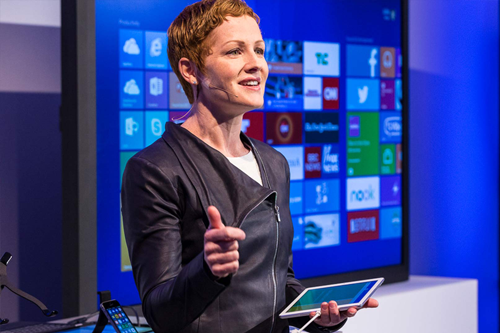In-Depth
What's the Deal with Microsoft's Mobile Strategy?
What mobile-first means now to Redmond in a (mostly) post-Windows Phone era.
- By Scott Bekker
- February 29, 2016
Nine months after Microsoft waved the white flag on Windows Phone, the company's new strategy in mobile is coming into sharper focus.
It was eight days into the current fiscal year, on July 8, that Microsoft CEO Satya Nadella announced a $7.6 billion writeoff related to the Nokia acquisition, a restructuring charge of $750 million to $850 million and 7,800 layoffs.
That was an undeniable admission that the company's attempt over the last half-decade to establish a beachhead for Windows Phone in the smartphone market against Apple Inc. and Google Inc. had failed.
In an open company memo, Nadella explained that Microsoft would keep producing first-party phones, but they would have a much, much lower priority for the company.
"I am committed to our first-party devices including phones," Nadella wrote. "However, we need to focus our phone efforts in the near term while driving reinvention. We are moving from a strategy to grow a standalone phone business to a strategy to grow and create a vibrant Windows ecosystem that includes our first-party device family."
Phones would be relegated to three areas where Microsoft could "make unique contributions" and "differentiate through the combination of our hardware and software," Nadella wrote. Rather than shooting for every segment of the entire global market, Microsoft would now design and market its phones for business customers with their requirements of management, security and productivity; for a limited set of value phone buyers; and for Windows enthusiasts with flagship phones.
The effect of the strategy change on the company's bottom line was evident in the late January earnings call to discuss second quarter results (the October-to-December period). "Devices revenue decreased 26 percent or 22 percent in constant currency, primarily due to phone, where revenue declined 49 percent in constant currency, reflecting our change in strategy announced last July," said Microsoft CFO Amy Hood.
The July 8 memo is one of the few public statements in which Nadella didn't use his signature phrase "mobile-first, cloud-first." Where does Windows Phone de-prioritization leave the mobile-first part of Microsoft's strategy? Largely unchanged. Microsoft has been backing away from Windows Phone organizationally since Nadella took over while the Nokia acquisition was underway. Unwinding former CEO Steve Ballmer's legacy deal largely reinforces five pillars of Microsoft's apparent strategy on mobility and Windows Phone in the Nadella era.
 "Devices revenue decreased 26 percent or 22 percent in constant currency, primarily due to phone where revenue declined 49 percent in constant currency, reflecting our change in strategy announced last July."
"Devices revenue decreased 26 percent or 22 percent in constant currency, primarily due to phone where revenue declined 49 percent in constant currency, reflecting our change in strategy announced last July."
Amy Hood, CFO, Microsoft
Pillars of Microsoft's 'Mobile-First' Strategy
1. Mobile-First Is a Loss Leader for Cloud-First
In the memo, Nadella talked about a strategy to "grow and create a vibrant Windows ecosystem." That's really to narrow a definition of what Microsoft is trying to do. Over the last few years, Microsoft has gone from having a handful of second-rate apps in the Apple App Store and Google Play store to having dozens of very strong apps -- including the dominant productivity apps of the Office suite.
Those apps don't create direct revenue in and of themselves for Microsoft. It's when users connect the apps to an Office 365 account that Microsoft starts to make money. And Microsoft is generating revenue on Office 365. During the same earnings report that included the nearly 50 percent drop in Windows Phone revenue, Office 365 was a revenue star. Office 365 commercial revenue grew nearly 70 percent in constant currency during the quarter and seats increased by nearly 60 percent. Across all cloud products, Microsoft claims an annual revenue run rate of $9.4 billion.
"We're also enthusiastic about how people use Office on other platforms. On iOS and Android, Skype has more than 900 million downloads and Office apps surpassed 340 million this quarter. There are also 30 million iOS and Android active devices running Outlook," Nadella said during the January call.
Microsoft has doubled down on the strategy since releasing the big Office apps -- Word, Excel and PowerPoint -- to the iOS and Android platforms. The company now has many other free apps that enhance the value of existing Office 365 subscriptions, and seems to be adding new ones every few weeks.
All that effort is aimed at restoring Microsoft, not Windows, to its former role as the dominant player across all office productivity platforms.
2. Buy Gaps in the Portfolio
Microsoft has long specialized in the little, functional acquisition -- picking up a boutique company doing a specific feature to plug a hole in an existing Microsoft product. The app store ecosystems, with their thousands of tiny companies surfacing their best ideas as individual apps, is like a candy store for Microsoft.
What's interesting is that some of the purchases Microsoft has made are in areas where it has core expertise. Rather than port the clean and critically acclaimed Outlook originally developed for Windows Phone, Microsoft surprisingly bought Outlook core functionality from three app companies that were already doing the functions well -- Accompli for core e-mail, Sunrise for calendaring, and Wunderlist for tasks and to-do lists.
In February, Microsoft continued the trend by spending a reported $250 million for SwiftKey, a replacement keyboard app specialist whose product overlaps innovative mobile keyboard work that Microsoft has done.
3. Mobile Can Drive UI Innovation
In some ways Microsoft prides itself on being a UI company. Some of Microsoft's best work on that front in the last few years came out of the mobile group. Windows Phone didn't take off from a market standpoint, but the group's interface design influenced the entire company and even the rest of the industry.
Its biggest legacy, the tile interface that inspired Windows 8, ended up being rolled back in Windows 10. But other elements have been very strong. Design elements from Windows Phone worked their way into iOS. The voice input and natural language recognition of Cortana is an important interface frontier for Microsoft that's becoming an element of many projects across the entire company. The shape typing developed for Windows Phone was another key invention.
By keeping mobile alive and working on flagship mobile devices, Microsoft's mobile team has the opportunity to continue generating new ideas that could benefit Microsoft's other platforms.

Those aren't all Microsoft devices. Scenes like this one, where Microsoft's Julia White demos Microsoft software running on iOS or on Android devices, are becoming increasingly common as Microsoft seeks to establish itself as the multi-platform productivity player.
4. Bet on a Unified Future
Before Windows Phone, there was Windows Mobile, a smartphone family with an interface that was much like a shrunk-down Windows desktop. It's back to the future with Windows 10 Continuum. The resizing is more elegant but the idea is the same -- one code base to run all devices. Since Apple came out with the iPhone in 2007, the dominant approach has been to have one OS for mobile devices and one for PCs.
Should the pendulum swing back, Microsoft is in a good position to capitalize. And there's always the outside chance that Microsoft can come up with a hit -- the killer hardware-software combo that changes everyone's expectations.
5. Keep a Dog in the Fight
Just after announcing the new strategy in July, Nadella faced investors on the fiscal year-end earnings call and said this in response to a question: "I believe our participation in the phone segment by itself, with Windows phones and Lumia phones being there, is important."
In technology, you never know when the mighty will stumble. With Microsoft's resources, keeping a smaller phone unit going could pay off if one of the big two players should unexpectedly collapse.
Bread and Butter
For now, the top two pillars seem dominant. Phones are an afterthought in Microsoft's overall strategy, as viewed from the outside. The more that Microsoft can create industry-best mobile productivity experiences, the better its cloud services revenues will be.
Microsoft has a few games in the portfolio, and a strong history in gaming, but the company's bread and butter has always been business and productivity. That's where the focus seems to be in its mobility strategy, as well.
When it comes time to stop playing Mobile Strike or Candy Crush and start getting stuff done, Microsoft is making a powerful case that it is the go-to app developer on the major mobile platforms.